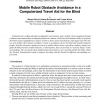Free Online Productivity Tools
i2Speak
i2Symbol
i2OCR
iTex2Img
iWeb2Print
iWeb2Shot
i2Type
iPdf2Split
iPdf2Merge
i2Bopomofo
i2Arabic
i2Style
i2Image
i2PDF
iLatex2Rtf
Sci2ools
ICRA
1994
IEEE
1994
IEEE
Mobile Robot Obstacle Avoidance in a Computerized Travel Aid for the Blind
A blind traveler walking through an unfamiliar environment, and a mobile robot navigating through a cluttered environment have an important feature in common: both have the kinematic ability to perform the motion, but are depended on a sensory system to detect and avoid obstacles. This paper describes the use of a mobile robot obstacle avoidance system as a guidance device for blind and visually impaired people. Just like electronic signals are sent to a mobile robot's motor controllers, auditory signals can guide the blind traveler around obstacles, or alternatively, they can provide an "acoustic image" of the surroundings. The concept has been implemented and tested in a new traveling aid for the blind, called the Navbelt. Experimental results of subjects traveling with the Navbelt in different surroundings are presented.
| Added | 08 Aug 2010 |
| Updated | 08 Aug 2010 |
| Type | Conference |
| Year | 1994 |
| Where | ICRA |
| Authors | Shraga Shoval, Johann Borenstein, Yoram Koren |
Comments (0)

